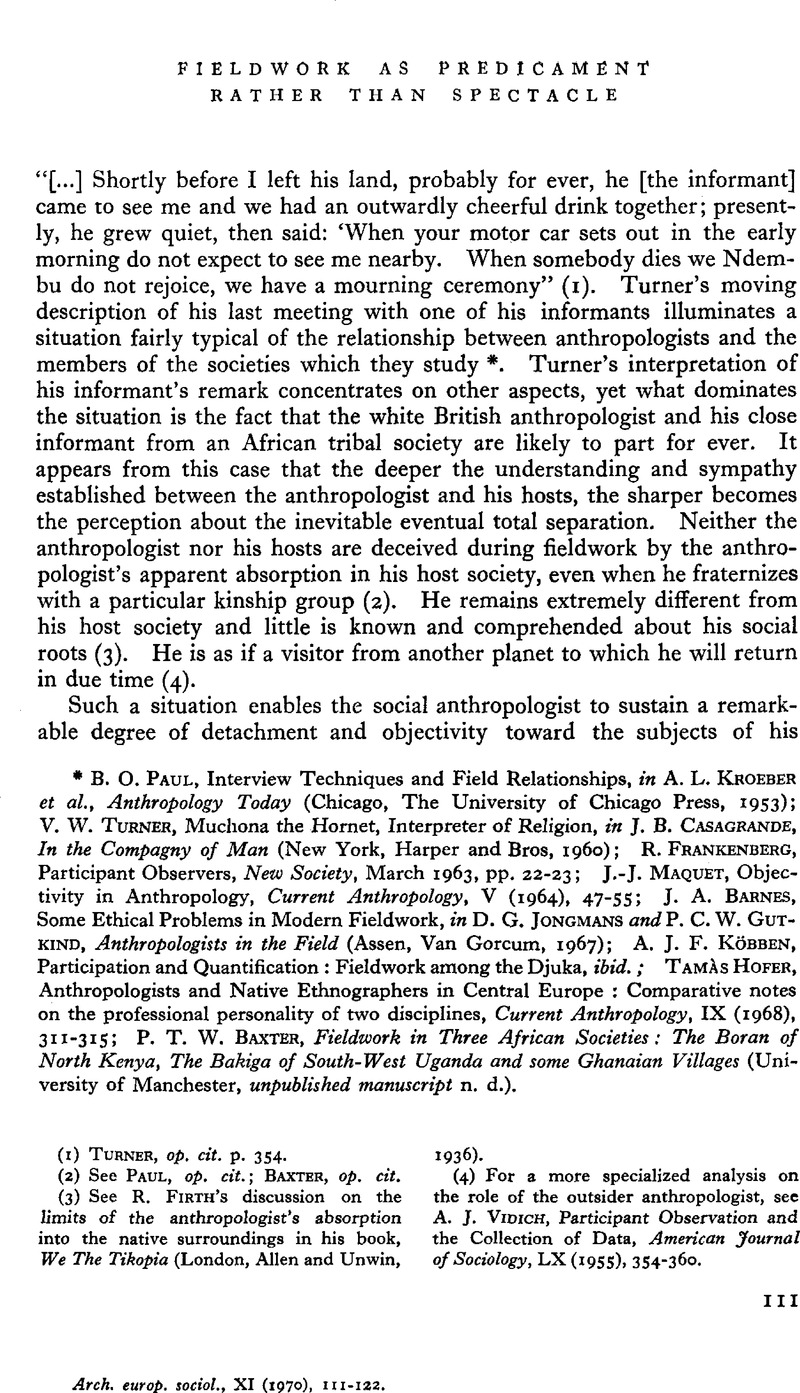Article contents
Fieldwork as Predicament rather than Spectacle
Published online by Cambridge University Press: 28 July 2009
Abstract

- Type
- Notes Critiques
- Information
- European Journal of Sociology / Archives Européennes de Sociologie , Volume 12 , Issue 1 , May 1971 , pp. 111 - 122
- Copyright
- Copyright © Archives Européenes de Sociology 1971
References
page 111 note * Paul, B. O., Interview Techniques and Field Relationships, in Kroeber, A. L. et al. , Anthropology Today (Chicago, The University of Chicago Press, 1953)Google Scholar; Turner, V. W., Muchona the Hornet, Interpreter of Religion, in Casagrande, J. B., In the Compagny of Man (New York, Harper and Bros, 1960)Google Scholar; Frankenberg, R., Participant Observers, New Society, 03 1963, pp. 22–23Google Scholar; J.-J- Maquet, Objectivity in Anthropology, Current Anthropology, V (1964), 47–55Google Scholar; Barnes, J. A., Some Ethical Problems in Modern Fieldwork, in Jongmans, D. G. and Gutkind, P. C. W., Anthropologists in the Field (Assen, Van Gorcum, 1967)Google Scholar; A. J. F. Köbben, Participation and Quantification: Fieldwork among the Djuka, ibid.; Hofer, Tamàs, Anthropologists and Native Ethnographers in Central Europe: Comparative notes on the professional personality of two disciplines, Current Anthropology, IX (1968), 311–315CrossRefGoogle Scholar; Baxter, P. T. W., Fieldwork in Three African Societies: The Boran of North Kenya, The Bakiga of South-West Uganda and some Ghanaian Villages (University of Manchester, unpublished manuscript n. d.)Google Scholar.
(1) Turner, , op. cit. p. 354.Google Scholar
(2) See Paul, op. cit.; Baxter, op. cit.
(3) See R. Firth's discussion on the limits of the anthropologist's absorption into the native surroundings in his book, We The Tikopia (London, Allen and Unwin, 1936)Google Scholar.
(4) For a more specialized analysis on the role of the outsider anthropologist, see Vidich, A. J., Participant Observation and the Collection of Data, American Journal of Sociology, LX (1955), 354–360CrossRefGoogle Scholar.
(5) Maybury-Lewis, D., The Savage and the Innocent (London, Evans Brothers, 1965)Google Scholar.
(6) See for instance West, J., Plainville, U.S.A. (New York, Columbia University Press, 1945)Google Scholar; Frankenberg, R., Village on the Border (London, Cohen and West, 1957)Google Scholar; ID. Participant Observers, loc. cit.
(7) Srinivas, M. N., Social Change in Modern India (Berkeley/Los Angeles, University of California Press, 1966)Google Scholar, See particularly Srinivas' own evaluation on is position as expressed in the essay: “Some Thought on the Study of One's Own Society”.
(8) Maquet, op. cit.; Cl. Lévi-Strauss, , The Scope of Anthropology, Current Anthropology, VII (1966), VII (1966), 112–123CrossRefGoogle Scholar; and from the same in the same volume, Anthropology: Its achievements and future, 124–127.
(9) Lévi-Strauss, , Anthropology… op. cit. p. 126Google Scholar. A somewhat similar argument was also raised by E. R. Leach in his discussion (in The British Journal of Sociology, XIV (1963), 377–378)Google Scholar on Srinivas' cited work; he posed the question: “How far can any sociologist understand his own society?” (p. 377).
(10) See Srinivas, op. cit.
(11) Maquet, op. cit.
(12) Shokeid, M. (Minkovitz), The Dual Heritage: Political and familial interaction of immigrants from the Atlas Mountains in an Israeli village (Manchester, Univerity Press, 1971)Google Scholar.
(13) ID. From Lineage to Association: Family organizations in the process of adjustment to the Moshav (Jerusalem, The Hebrew University, 1967)Google Scholar (in Hebrew with English summary). ID. Immigration and Factionalism: An analysis of factions in rural Israeli communities of immigrants, British Journal of Sociology, XIX (1968), 385–406Google Scholar.
(14) See Barnes, op. cit.
(15) Whyte, W. F., Street Corner Society (Chicago, The University of Chicago Press, 1965), appendix, pp. 279–356Google Scholar.
(16) In this context see also Chaudhri's recent account on the particular problems she had to cope during fieldwork, due to her affinal relationship with one group: Chaudhri, J., A Typical Support Structure of Leadership in Punjab: The faction (University of Manchester, unpublished thesis 1969)Google Scholar.
(17) See Tamàs Hofer, op. cit.
(18) Deshen, S. A., Immigrant Voters in Israel: Parties and congregations in a local election campaign (Manchester, Manchester University Press, 1970)Google Scholar.
(19) Maquet, , op. cit. p. 54Google Scholar.
(20) Leach, op. cit.; Srinivas, op. cit.
(21) See Leach, op. cit.
(22) See in particular Barnes' discussion (op. cit.) in relation to some of the problems involved.
page 122 note * I am indebted to the Bernstein Schem for Anthropological Research in Israel which enabled me to carry out fieldwork reported and analysed in this paper. The paper was written during my stay at Manchester University as a research fellow in social anthropology. I should like to thank Professor M. Gluckman and Dr. P. T. W. Baxter for their helpful comments. I am particulary indebted to Dr. Joyce Chaudhri; it is mainly due to the discussions we had that I came to write this paper. I should also like to thank Dr. S. A. Deshen, my colleague at Tel-Aviv University, and Dr. E. Cohen of the Hebrew University for their helpful comments on the manuscript.
- 2
- Cited by




